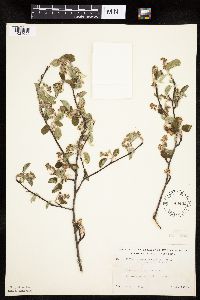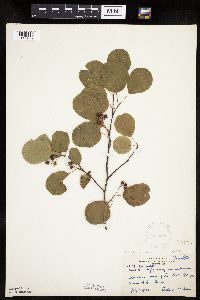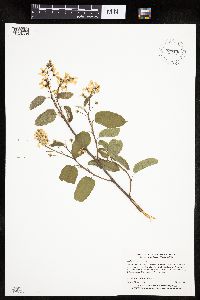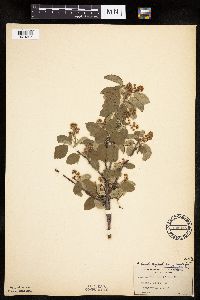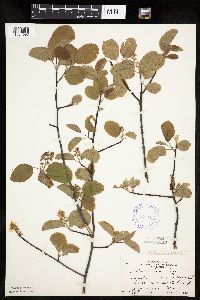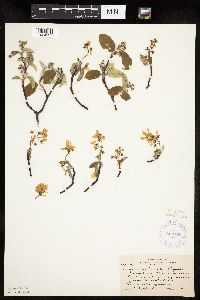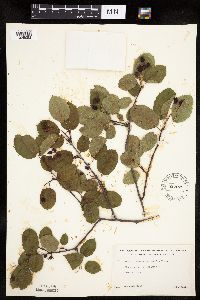Amelanchier sanguinea
|
|
|
|
Family: Rosaceae
Round-Leaf Service-Berry
[Pyrus sanguinea Pursh] |
Shrub or small tree 1 - 3 m tall Leaves: stalked, 3 - 7 cm long, one to one and a half times as long as wide, oblong to nearly rounded with a rounded to blunt or slightly pointed tip and rounded to nearly heart-shaped base, usually having less than twenty teeth per side, more or less hairless with few hairs along the midvein, with each of the parallel veins ending at a tooth. At flowering, the leaves are half expanded and covered with pale hairs on the lower surface. Flowers: borne on a loose, often drooping inflorescence (raceme) 4 - 7 cm long, with nearly hairless individual flower stalks to 2.5 cm long. Each flower is white with a recurved five-lobed calyx, five narrow spoon-shaped to linear petals 1 - 1.5 cm long, and a densely hairy ovary tip. Fruit: berry-like (pome), clustered, nearly black, spherical, juicy, covered with a whitish waxy coating (glaucous), containing ten seeds. Twigs: reddish. Buds: narrow, reddish brown, 6 - 7 mm long, dull. Form: erect or straggling, with one or several slender trunks, not colony-forming. Similar species: Amelanchier sanguinea, Amelanchier humilis, and Amelanchier spicata are the three Amelanchier species in the Chicago Region under 3 m tall at maturity. Amelanchier spicata and A. humilis both form colonies and have dense, upright inflorescences. In addition, A. spicata has leaves that are one-quarter to one-half expanded at flowering and leaf veins that interconnect near the margin, while A. humilis has leaves that are expanding or fully expanded at flowering time and hairy flower stalks. Flowering: early to mid May Habitat and ecology: Rare along river banks or in open woods. Occurence in the Chicago region: native Etymology: Amelanchier is the old French name of a species in this genus. Sanguinea means blood-red. Author: The Morton Arboretum Erect or straggling shrub or small tree to 3(-6) m, usually with several clumped stems; lvs at anthesis half-grown and tomentose beneath, eventually glabrous, oblong to subrotund or quadrate, to 7 cm, mostly 1-1.5 times as long as wide, rather coarsely toothed (often only above the middle), with mostly 3-5 teeth per cm of margin, seldom more than 20 per side; lateral veins more than half as many as the teeth, parallel, straight or slightly curved, simple or once (rarely twice) forked, each vein or fork running to a tooth; racemes loose and open, the lower pedicels mostly (1-)1.5-3(-4) cm; sep recurved from near the middle after anthesis; ovary tomentose at the summit; mostly polyploid. Mostly in open woods; Me. and s. Que. to Minn., s. to N.Y., n. N.J., Mich., and Io., and irregularly in the mts. to N.C. and Tenn. May, June. Var. sanguinea, with the range of the species, has pedicels to 3 cm, the pedicels and sep usually retaining their tomentum until after anthesis; the hypanthium is cupulate, 4-7 mm wide, and the pet are mostly 10-18 mm. (A. humilis; A. huronensis) Var. grandiflora (Wiegand) Rehder, restricted to c. N.Y., has the pedicels and hypanthium soon glabrescent, the hypanthium saucer-shaped and 7-9 mm wide, the pedicels 2.5-4 cm, and the pet 15-22 mm. (A. amabilis) Gleason, Henry A. & Cronquist, Arthur J. 1991. Manual of vascular plants of northeastern United States and adjacent Canada. lxxv + 910 pp. ©The New York Botanical Garden. All rights reserved. Used by permission. From Flora of Indiana (1940) by Charles C. Deam Indiana Coefficient of Conservatism: C = 10 Wetland Indicator Status: N/A Diagnostic Traits: Shrub or small tree; leaves tomentose when young, some hairs persisting into maturity; leaf margin near petiole with mostly 3–6 teeth per cm; lower pedicels of raceme to 2.5 cm; sepals recurved or spreading; larger petals >10 mm long; ovary inferior, its top hairy. |















